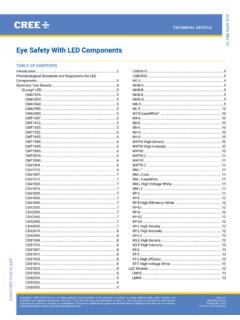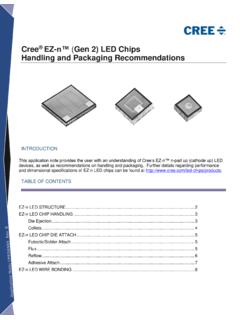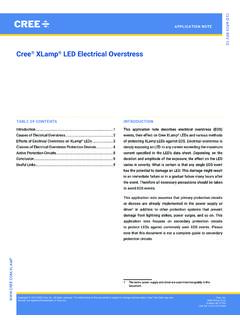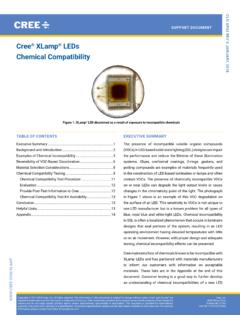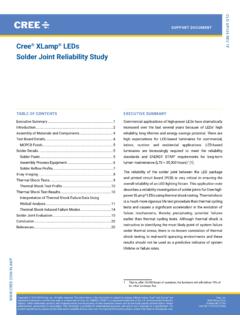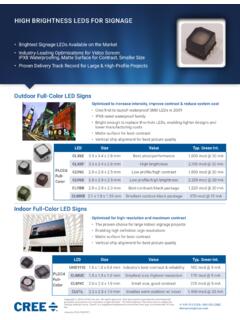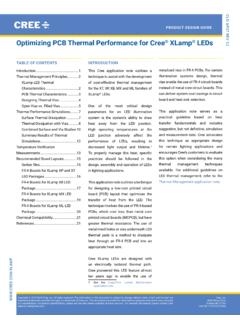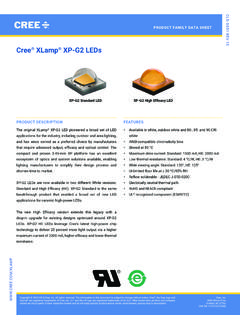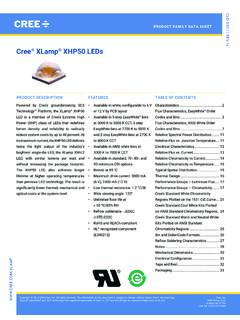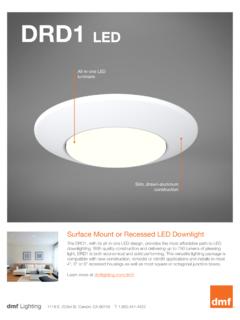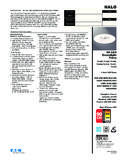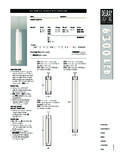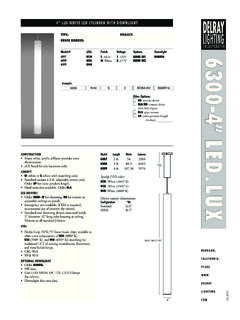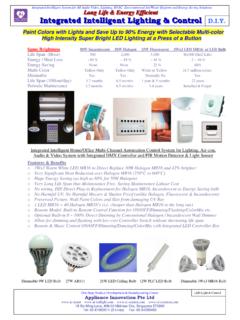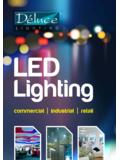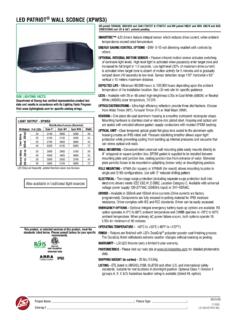Transcription of CLD-AP15 rev 0 LED Luminaire Design Guide - Cree …
1 CLD-AP15 rev 0E. Application Note LED Luminaire Design Guide Table of Contents Introduction 1 This application note provides guidelines for the process of Design 2 designing high-power LEDs into luminaires. This document Design 3 uses an indoor Luminaire Design as an example, but the process 1. Define Lighting 4 described can be applied to the Design of any LED Luminaire . 2. Define Design 5. Lighting-class LEDs are now available that deliver the 3. Estimate Efficiencies of the Optical, Thermal & Electrical brightness, efficacy, lifetime, color temperatures, and white- 6. point stability required for general illumination. As a result, these 4. Calculate Number of LEDs 9. LEDs are being designed into most general lighting applications, 5. Consider All Design Possibilities & Choose the 10. including roadway, parking area, and indoor directional lighting. 6. Final 14. LED based luminaires reduce total-cost-of-ownership (TCO) in Where to Get 15.
2 These applications through maintenance avoidance (since LEDs last much longer than traditional lamps) and reduced energy costs. There are over 20 billion light fixtures using incandescent, halogen, or fluorescent lamps worldwide. Many of these fixtures are being used for directional light applications but are based on lamps that put out light in all directions. The United States Department of Energy (DOE) states that recessed downlights are the most common installed Luminaire type in new residential Copyright 2007-2016 Cree, Inc. All rights reserved. The information in this document is subject to change without notice. Cree and XLamp are Cree, Inc. registered trademarks and the Cree logo is a trademark of Cree, Inc. Other trademarks, product and company names are the property of their respective 4600 Silicon Drive owners and do not imply specific product and/or vendor endorsement, sponsorship or association. This document is provided for informational Durham, NC 27703.
3 Purposes only and is not a warranty or a specification. For product specifications, please see the data sheets available at For warranty USA Tel: + information, please contact Cree Sales at LED Luminaire Design Guide In addition, the DOE reports that downlights using non-reflector lamps are typically only 50% efficient, meaning half the light produced by the lamp is wasted inside the fixture. In contrast, lighting-class LEDs offer efficient, directional light that lasts at least 50,000 hours. Indoor luminaires designed to take advantage of all the benefits of lighting-class LEDs can: Exceed the efficacy of any incandescent and halogen Luminaire . Match the performance of even the best CFL (compact fluorescent) recessed downlights. Provide a lifetime five to fifty times longer than these lamps before requiring maintenance. Reduce the environmental impact of light: no mercury, less power-plant pollution, and less landfill waste. Design Approach Luminaires or Lamps?
4 Designing LEDs into general illumination requires a choice between designing either a complete Luminaire based on LEDs or an LED based lamp meant to install into an existing fixture. Generally, a complete Luminaire Design will have better optical, thermal and electrical performance than the retrofit lamp, since the existing fixture does not constrain the Design . It is up to the designer to decide whether the total system performance of a new Luminaire or the convenience of a retrofit lamp is more important in the target application. Target Existing Luminaires If the target application is better served by creating a new LED Luminaire , then designing the Luminaire 's light output to match or exceed an existing Luminaire has several advantages. First, an existing Design is already optimized to target a known application, and can provide guidance for setting the Design goals around light output, cost, and operating environment. Second, an existing Design is already in an accepted form factor.
5 Switching to the LED Luminaire is easier for the end user if the form factors are the same. Unfortunately, some LED Luminaire manufacturers are misreporting or inflating claims of LED Luminaire efficacy and lifetime characteristics. The lighting industry saw similar problems during the early years of CFL replacement bulbs. The lack of industry standards and wide variations in early product quality delayed the adoption of CFL technology for many years. The United States Department of Energy is aware that the same standards and quality problems may exist with early LED luminaires and that these problems may delay the adoption of LED light in a similar fashion. In response, it launched the DOE SSL Commercial Product Testing Program (CPTP) to test the claims of LED- Luminaire makers. This program anonymously tests LED-based luminaires for the following four characteristics: Luminaire light output (lumens). Luminaire efficacy (lumens per watt).
6 Correlated color temperaure (degrees Kelvin). Color-rendering index DOE's CPTP sets a good precedent for LED Luminaire Design by focusing on the usable light output of a Luminaire not just the light output of the light source. 1 Department of Energy, Energy Efficiency and Renewable Energy. LED Application Series: Recessed Downlights. Copyright 2007-2016 Cree, Inc. All rights reserved. The information in this document is subject to change without notice. Cree and XLamp are registered trademarks and the Cree logo is a trademark of Cree, Inc. Other trademarks, product and company names are the property of their respective owners and do not imply specific product and/or vendor endorsement, sponsorship or association. This document is provided for informational purposes only and is not a warranty or a specification. For product specifications, please see the data sheets available at For warranty information, please contact Cree Sales at 2.
7 LED Luminaire Design Guide The Idea of a Lamp May Be Outdated The long lifetime of LED light may make the idea of a lamp outdated. Lighting-class LEDs do not fail catastrophically like light bulbs. Instead, they can provide at least 50,000 hours of useful lifetime before they gracefully degrade below 70%. of their initial light output (also called lumen maintenance). That's equal to years if left on continuously! However, in most lighting situations, the lights are switched off regularly. This off period can extend the lifetime of the LED well past three decades, as shown in Chart 1 (at right). After the years it will take for an LED Luminaire to burn out, . LED lighting technology will be brighter, more efficient, and probably offer TCO savings over the older LED Luminaire . Chart 1: What 50,000 hours means in practical terms Keep in mind how much environmental impact was avoided over that 50,000 hours of LED Luminaire lifetime: At least 25 fewer incandescent bulbs were sent to landfills AND five times less energy used.
8 (About 50% of power in the United States comes from burning coal, which releases mercury into the air.). Or, at least 5 fewer CFL bulbs containing mercury sent for disposal. As mentioned previously, maintenance avoidance is an important benefit for LED luminaires. Therefore, designing the LED Luminaire to deliver maximum lifetime and provide TCO savings is an excellent strategy to overcome the hurdle of the higher initial cost of LED-based luminaires. Design Process Table 1 lists a general process for designing high-power LEDs into a Luminaire . The rest of the document walks through these Design steps in order. To better illustrate these Design concepts, this document includes example calculations for an LED Luminaire meant to replace a 23-W CFL downlight. This Design process is repeatable for all kinds of luminaires and not just the example included. Copyright 2007-2016 Cree, Inc. All rights reserved. The information in this document is subject to change without notice.
9 Cree and XLamp are registered trademarks and the Cree logo is a trademark of Cree, Inc. Other trademarks, product and company names are the property of their respective owners and do not imply specific product and/or vendor endorsement, sponsorship or association. This document is provided for informational purposes only and is not a warranty or a specification. For product specifications, please see the data sheets available at For warranty information, please contact Cree Sales at 3. LED Luminaire Design Guide Table 1: Process for designing high-power LEDs into luminaires Step Explanation The Design goals should be based either on an existing fixture's performance or on the application's 1. Define lighting requirements lighting requirements. Specify Design goals, which will be based on the application's lighting requirements. 2. Define Design goals The designer should specify any other goals that will influence the Design , such as special optical requirements or being able to withstand high temperatures.
10 Design goals will place constraints on the optical, thermal and electrical systems. 3. Estimate efficiencies of the optical, thermal & electrical Good estimations of efficiencies of each system can be made based on these constraints. systems The combination of lighting goals and system effiiciencies will drive the number of LEDs needed in the Luminaire . Based on the Design goals and estimated losses, the designer can calculate the number of LEDs 4. Calculate the number of LEDs needed needed to meet the Design goals. As with any Design , there are many different ways to best achieve the Design goals. 5. Consider all Design possibilities and choose the best LED lighting is still a new field, so assumptions that work for conventional lighting sources may not apply to LED lighting Design . Complete circuit board layout. Test Design choices by building a prototype Luminaire . 6. Complete final steps Make sure the Design achieves all the Design goals.

